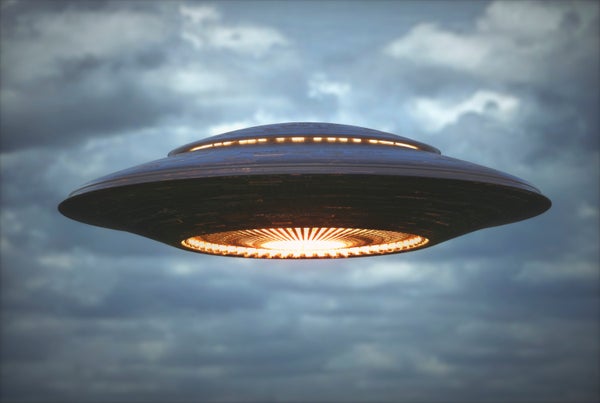The Pentagon report on unidentified aerial phenomena (UAP) that was delivered to Congress on June 25 is intriguing enough to motivate scientific inquiry towards the goal of what these phenomena are. The nature of UAP is not a philosophical matter. It’s also not a puzzle that politicians should be asked to resolve—for the same reason that plumbers should not be asked to bake cakes. Policy makers or military personnel have insufficient training in science to solve this mystery, and hoping that they will somehow do so is like the frustrating experience of the characters in Samuel Beckett’s play Waiting for Godot.
Given these circumstances, scientists should find the answer through the standard scientific process, based on a transparent analysis of open data. The task boils down to getting a high-resolution image of UAP. A picture is worth a thousand words. More specifically, a megapixel image of the surface of an unusual object will allow us to distinguish whether it bears the metaphorical label “Made in China” or “Made in Russia” from the alternative: “Made on Exoplanet X.”
Consider an object the size of a person at a distance of one mile. Suppose we wish to resolve features as small as the width of a letter in this text. That is equivalent to resolving a thousandth of the person’s height, which would require obtaining a megapixel image. The Rayleigh criterion in optics implies that the best angular resolution of a telescope is at the so-called “diffraction limit,” roughly the wavelength of light divided by the aperture diameter. For visible light, the desired resolution in our example can be obtained by a telescope with a diameter of a meter, which can be purchased off-the-shelf online.
On supporting science journalism
If you're enjoying this article, consider supporting our award-winning journalism by subscribing. By purchasing a subscription you are helping to ensure the future of impactful stories about the discoveries and ideas shaping our world today.
The telescope should be linked to a suitable camera, with the resulting data stream fed to a computer system—where optimized software would filter out the transients of interest as the telescope tiles the sky with its field of view. The initial survey could start from a large field of view, but then zoom in on the object of interest as it is tracked across the sky. UAP could change their sky position much faster than any astronomical sources located at great distances.
But they also need to be distinguished from birds, airplanes, satellites or instrumental artifacts. The actual fidelity of the image will be limited by blurring owing to atmospheric turbulence and will therefore depend on the elevation and distance of the UAP. The sky survey will also need to extend over a period of time long enough for the detection of UAP to be probable. These are all major challenges.
The telescope facilities can be placed in geographical locations that will maximize the chance of reproducing past UAP reports. Lower-cost video cameras with lower resolution can be distributed across more locations around the globe to achieve a comprehensive survey of the entire sky. There are astronomical facilities, such as ZTF, LCO, TAOS, ASASSN or PanSTARRS, already in place at remote locations for the different task of searching for transient objects that do not move across the sky as fast as UAP. The data volume will increase dramatically when the VRO/LSST facility in Chile commences operations in 2023. UAP debunkers often ask why cameras invariably capture fuzzy images of unidentified objects. The answer is simple: their apertures are hundreds of times smaller than the desired meter-scale telescopes.
The cost of establishing a network of suitable telescopes is lower than the amount invested so far in the search for the nature of dark matter. We do not know which particles constitute most of the matter in the universe. It is a search compromised by uncertainties, just like the search for UAP. But if some of the UAP are of extraterrestrial origin, the implications would be far greater for society than proving that dark matter is weakly interacting massive particles (WIMPs) as opposed to something else. The extraterrestrial finding may well change the way we perceive our place in the universe, our aspirations for space, our theological and philosophical beliefs and even the way we treat other humans.
And all of these implications can be triggered by a single megapixel image obtained at a reasonable cost. In a forum that I attended recently concerning my book Extraterrestrial, I was asked about the prior probability assigned to the possibility that the weird interstellar object ‘Oumuamua or UAP are extraterrestrial in origin. I clarified that it is unknown just as in the case of dark matter being WIMPs. But since a megapixel image of UAP is affordable and is of great interest to the public and the government, we should simply obtain one. Indeed, a picture of an ‘Oumuamua-like object would be worth 66,000 words—the number of words in my book. We should not seek data from government-owned sensors that were not designed for this purpose, but instead collect our own state-of-the-art scientific data in a reproducible fashion. Most of the sky above us is not classified.
In a podcast interview I recently had with a young audience, they agreed: “Let’s just do it.” It was refreshing to see eye-to-eye with the torch bearers of the future, as well as with potential funders of the UAP imaging project, all within the same week. A day later, I was asked by Rahel Solomon of CNBC: “How do you plan to celebrate UAP Day?” Thankful for the reminder, I said: “We will probably need our computers to figure out the nature of UAP, and so my plan is to celebrate the day with my computer.”
This is an opinion and analysis article; the views expressed by the author or authors are not necessarily those of Scientific American.
